An Equity Evaluation of Healthcare Accessibility across Age Strata Using the G2SFCA Method: A Case Study in Karamay District, China
Abstract
:1. Introduction
2. Literature Review
2.1. Measuring Healthcare Accessibility
2.2. The Equity of Healthcare Accessibility
3. Study Area and Data
3.1. Study Area
3.2. Data
3.2.1. Road Network and Healthcare Facility Data
3.2.2. Demographic Indicators
4. Methods
4.1. Measuring Accessibility
4.2. Spatial Autocorrelation
4.3. Equity Analysis
5. Results
5.1. Accessibility of Two Types of Healthcare Facilities
5.2. Spatial Agglomeration Characteristics
5.3. Equity Evaluation
5.3.1. Equality of Healthcare Accessibility
5.3.2. Equity across Age Strata
6. Discussion
6.1. Interpreting Results
6.2. Planning Implications
6.3. Assumptions and Limitations
7. Conclusions
Supplementary Materials
Author Contributions
Funding
Data Availability Statement
Acknowledgments
Conflicts of Interest
References
- Rocco, R.; Bracken, G.; Newton, C.; Dabrowski, M. Teaching, Learning & Researching: Spatial Planning; TU Delft OPEN Books: Delft, The Netherlands, 2022. [Google Scholar] [CrossRef]
- Sen, A. The Idea of Justice; Harvard University Press: Cambridge, MA, USA, 2011. [Google Scholar]
- Soja, E.W. Seeking Spatial Justice; University of Minnesota Press: Minneapolis, MN, USA, 2013. [Google Scholar]
- Guagliardo, M.F. Spatial accessibility of primary care: Concepts, methods and challenges. Int. J. Health Geogr. 2004, 3, 3. Available online: https://www.webofscience.com/wos/alldb/full-record/MEDLINE:14987337 (accessed on 20 May 2024). [CrossRef] [PubMed]
- Luo, W.; Wang, F. Measures of Spatial Accessibility to Health Care in a GIS Environment: Synthesis and a Case Study in the Chicago Region. Environ. Plan. B Plan. Des. 2003, 30, 865–884. [Google Scholar] [CrossRef] [PubMed]
- Guida, C.; Carpentieri, G. Quality of life in the urban environment and primary health services for the elderly during the COVID-19 pandemic: An application to the city of Milan (Italy). Cities 2020, 110, 103038. [Google Scholar] [CrossRef] [PubMed]
- Omer, I. Evaluating accessibility using house-level data: A spatial equity perspective. Comput. Environ. Urban Syst. 2006, 30, 254–274. [Google Scholar] [CrossRef]
- Plachkinova, M.; Vo, A.; Bhaskar, R.; Hilton, B. A conceptual framework for quality healthcare accessibility: A scalable approach for big data technologies. Inf. Syst. Front. 2018, 20, 289–302. [Google Scholar] [CrossRef]
- Boisjoly, G.; Deboosere, R.; Wasfi, R.; Orpana, H.; Manaugh, K.; Buliung, R.; El-Geneidy, A. Measuring accessibility to hospitals by public transport: An assessment of eight Canadian metropolitan regions. J. Transp. Health 2020, 18, 100916. [Google Scholar] [CrossRef]
- Zhang, Y. Access to Healthcare Facilities and Women’s Healthcare Requirements in Urban Areas: A Case Study of Beijing. Int. J. Environ. Res. Public Health 2022, 19, 3709. [Google Scholar] [CrossRef]
- Shao, H.; Jin, C.; Xu, J.; Zhong, Y.; Xu, B. Supply-demand matching of medical services at a city level under the background of hierarchical diagnosis and treatment-based on Didi Chuxing Data in Haikou, China. BMC Health Serv. Res. 2022, 22, 354. [Google Scholar] [CrossRef] [PubMed]
- Falchetta, G.; Hammad, A.T.; Shayegh, S. Planning universal accessibility to public health care in sub-Saharan Africa. Proc. Natl. Acad. Sci. USA 2020, 117, 31760–31769. [Google Scholar] [CrossRef]
- Bodhisane, S.; Pongpanich, S. The impact of National Health Insurance upon accessibility of health services and financial protection from catastrophic health expenditure: A case study of Savannakhet province, the Lao People’s Democratic Republic. Health Res. Policy Syst. 2019, 17, 99. [Google Scholar] [CrossRef]
- Huotari, T.; Antikainen, H.; Keistinen, T.; Rusanen, J. Accessibility of tertiary hospitals in Finland: A comparison of administrative and normative catchment areas. Soc. Sci. Med. 2017, 182, 60–67. [Google Scholar] [CrossRef] [PubMed]
- Agha, L.; Ericson, K.M.; Zhao, X. The impact of organizational boundaries on health care coordination and utilization. Am. Econ. J. Econ. Policy 2023, 15, 184–214. [Google Scholar] [CrossRef] [PubMed]
- Jin, T.; Cheng, L.; Wang, K.; Cao, J.; Huang, H.; Witlox, F. Examining equity in accessibility to multi-tier healthcare services across different income households using estimated travel time. Transp. Policy 2022, 121, 1–13. [Google Scholar] [CrossRef]
- Surendra, H.; Salama, N.; Lestari, K.D.; Adrian, V.; Widyastuti, W.; Oktavia, D.; Lina, R.N.; A Djaafara, B.; Fadilah, I.; Sagara, R.; et al. Pandemic inequity in a megacity: A multilevel analysis of individual, community and healthcare vulnerability risks for COVID-19 mortality in Jakarta, Indonesia. BMJ Glob. Health 2022, 7, e008329. [Google Scholar] [CrossRef] [PubMed]
- Liu, J.; Cao, Y.; Wang, Y.; Ren, F.; Du, Q. Evaluating the Accessibility of Medical Services in the 15 min Life Circle Using Internet Pan-Map Resources: A Case Study in Shanghai. Geomat. Inf. Sci. Wuhan Univ. 2022, 47, 2054–2063. [Google Scholar] [CrossRef]
- Bokhari, A.; Sharifi, F. Simultaneous inequity of elderly residents in Melbourne metropolitan. Metropolitan. Sustainability 2023, 15, 2189. [Google Scholar] [CrossRef]
- Cardoso, R.V. City-regional demographic composition and the fortunes of regional second cities. Urban Geogr. 2023, 44, 1541–1563. [Google Scholar] [CrossRef]
- Wang, L.; Liu, L. The Present Condition of China’s Medical and Health Facilities in the Epidemic Situation of COVID-19, and a Comparison with Other Countries. Sci. Technol. Rev. 2020, 38, 29–38. Available online: https://kns.cnki.net/KCMS/detail/detail.aspx?dbcode=CJFD&dbname=CJFDLAST2020&filename=KJDB202004006&v= (accessed on 24 May 2024).
- Shen, Y.; Shi, Y.W.; Wang, H.X.; Sun, B.Y. The Impacts of Medical Facility Accessibility on Patients’ Medical Treatment Space: A Case Study in Shanghai. Urban Stud. 2019, 26, 46–52+61. Available online: https://kns.cnki.net/KCMS/detail/detail.aspx?dbcode=CJFD&dbname=CJFDLAST2020&filename=CSFY201912007&v= (accessed on 24 May 2024).
- Zhang, Q.; Li, T.; Ren, X. Study on the Accessibility of Urban Community Health Institutions under Grading Treatment System: A Case Study of Xi’an Downtown. J. Shaanxi Norm. Univ. (Nat. Sci. Ed.) 2016, 44, 87–93. [Google Scholar] [CrossRef]
- Wei, Z.; Bai, J. Measuring spatial accessibility of residents’ medical treatment under hierarchical diagnosis and treatment system: Multi-scenario simulation in China. PLoS ONE 2023, 18, e0282713. [Google Scholar] [CrossRef] [PubMed]
- Shen, Y.; Li, L. Progress of Research on Medical Resource Accessibility and Residents’ Health Seeking Behavior. Sci. Technol. Rev. 2020, 38, 85–92. Available online: https://kns.cnki.net/KCMS/detail/detail.aspx?dbcode=CJFD&dbname=CJFDLAST2020&filename=KJDB202007013&v= (accessed on 24 May 2024).
- Wang, F. Measurement, Optimization, and Impact of Health Care Accessibility: A Methodological Review. Ann. Assoc. Am. Geogr. 2012, 102, 1104–1112. [Google Scholar] [CrossRef] [PubMed]
- Hansen, W.G. How Accessibility Shapes Land Use. J. Am. Inst. Plan. 1959, 25, 73–76. [Google Scholar] [CrossRef]
- Ben-Akiva, M.; Lerman, S.R. Disaggregate Travel and Mobility-Choice Models and Measures of Accessibility. In Behavioural Travel Modelling; Routledge: London, UK, 1979. [Google Scholar]
- Lenntorp, B. Paths in Space-Time Environments. A Time-Geographic Study of Movement Possibilities of Individuals. Lund Stud. Geogr. Hum. Geogr. 1976. [Google Scholar]
- Khan, A.A. An integrated approach to measuring potential spatial access to health care services. Socio-Econ. Plan. Sci. 1992, 26, 275–287. [Google Scholar] [CrossRef] [PubMed]
- Khan, A.; Bhardwaj, S. Access to Health-Care—A Conceptual-Framework and Its Relevance to Health-Care Planning. Eval. Health Prof. 1994, 17, 60–76. [Google Scholar] [CrossRef] [PubMed]
- Kwan, M.P. Space-time and integral measures of individual accessibility: A comparative analysis using a point-based framework. Geogr. Anal. 1998, 30, 191–216. [Google Scholar] [CrossRef]
- Joseph, A.E.; Phillips, D.R. Accessibility and Utilization: Geographical Perspectives on Health Care Delivery; Harper & Row: London, UK, 1984. Available online: https://www.ncbi.nlm.nih.gov/pmc/articles/PMC1959857/ (accessed on 19 June 2024).
- Thouez, J.-P.M.; Bodson, P.; Joseph, A.E. Some Methods for Measuring the Geographic Accessibility of Medical Services in Rural Regions. Med. Care 1988, 26, 34. Available online: https://journals.lww.com/lww-medicalcare/abstract/1988/01000/some_methods_for_measuring_the_geographic.4.aspx (accessed on 15 April 2024). [CrossRef] [PubMed]
- Xu, R.; Yue, W.; Wei, F.; Yang, G.; Chen, Y.; Pan, K. Inequality of public facilities between urban and rural areas and its driving factors in ten cities of China. Sci. Rep. 2022, 12, 13244. [Google Scholar] [CrossRef]
- Yin, C.; He, Q.; Liu, Y.; Chen, W.; Gao, Y. Inequality of public health and its role in spatial accessibility to medical facilities in China. Appl. Geogr. 2018, 92, 50–62. [Google Scholar] [CrossRef]
- Du, M.; Zhao, S. An Equity Evaluation on Accessibility of Primary Healthcare Facilities by Using V2SFCA Method: Taking Fukuoka City, Japan, as a Case Study. Land 2022, 11, 640. [Google Scholar] [CrossRef]
- Guida, C.; Carpentieri, G.; Masoumi, H. Measuring spatial accessibility to urban services for older adults: An application to healthcare facilities in Milan. Eur. Transp. Res. Rev. 2022, 14, 23. [Google Scholar] [CrossRef] [PubMed]
- Song, Z.; Chen, W.; Che, Q.; Zhang, L. Measurement of Spatial Accessibility to Health Care Facilities and Defining Health Professional Shortage Areas Based on Improved Potential Model—A Case Study of Rudong County in Jiangsu Province. Sci. Geogr. Sin. 2010, 30, 213–219. [Google Scholar] [CrossRef]
- Cheng, M.; Lian, Y. Spatial Accessibility of Urban Medical Facilities Based on Improved Potential Model: A Case Study of Yangpu District in Shanghai. Prog. Geogr. 2018, 37, 266–275. [Google Scholar] [CrossRef]
- Shen, Q. Location characteristics of inner-city neighborhoods and employment accessibility of low-wage workers. Environ. Plan. B Plan. Des. 1998, 25, 345–365. [Google Scholar] [CrossRef]
- Radke, J.; Mu, L. Spatial Decompositions, Modeling and Mapping Service Regions to Predict Access to Social Programs. Ann. GIS 2000, 6, 105–112. [Google Scholar] [CrossRef]
- McGrail, M.R. Spatial accessibility of primary health care utilizing the two step floating catchment area method: An assessment of recent improvements. Int. J. Health Geogr. 2012, 11, 50. [Google Scholar] [CrossRef]
- Tao, Z.; Cheng, Y. Research Progress of the Two-step Floating Catchment Area Method and Extensions. Prog. Geogr. 2016, 35, 589–599. Available online: https://kns.cnki.net/KCMS/detail/detail.aspx?dbcode=CJFD&dbname=CJFDLAST2016&filename=DLKJ201605006&v= (accessed on 2 June 2024).
- Dai, D. Black residential segregation, disparities in spatial access to health care facilities, and late-stage breast cancer diagnosis in metropolitan Detroit. Health Place 2010, 16, 1038–1052. [Google Scholar] [CrossRef]
- Wan, N.; Zou, B.; Sternberg, T. A three-step floating catchment area method for analyzing spatial access to health services. Int. J. Geogr. Inf. Sci. 2012, 26, 1073–1089. [Google Scholar] [CrossRef]
- Wang, F. Inverted Two-Step Floating Catchment Area Method for Measuring Facility Crowdedness. Prof. Geogr. 2018, 70, 251–260. [Google Scholar] [CrossRef]
- Yang, D.-H.; Goerge, R.; Mullner, R. Comparing GIS-Based Methods of Measuring Spatial Accessibility to Health Services. J. Med. Syst. 2006, 30, 23–32. [Google Scholar] [CrossRef] [PubMed]
- Brondeel, R.; Weill, A.; Thomas, F.; Chaix, B. Use of healthcare services in the residence and workplace neighbourhood: The effect of spatial accessibility to healthcare services. Health Place 2014, 30, 127–133. [Google Scholar] [CrossRef]
- Zhong, S.; Yang, X.; Chen, R. The Accessibility Measurement of Hierarchy Public Service Facilities Based on Multi-mode Network Dataset and the Two-step 2SFCA: A Case Study of Beijing’s Medical Facilities. Geogr. Res. 2016, 35, 731–744. Available online: https://kns.cnki.net/KCMS/detail/detail.aspx?dbcode=CJFD&dbname=CJFDLAST2016&filename=DLYJ201604012&v= (accessed on 2 June 2024).
- Wang, S.; Sadahiro, Y. Horizontal and vertical inequity of multi-modal healthcare accessibility in the aging Japan in the post-COVID era: A GIS-based approach. Int. J. Digit. Earth 2024, 17, 2310731. [Google Scholar] [CrossRef]
- McGrail, M.R.; Humphreys, J.S. Measuring spatial accessibility to primary care in rural areas: Improving the effectiveness of the two-step floating catchment area method. Appl. Geogr. 2009, 29, 533–541. [Google Scholar] [CrossRef]
- Blumenberg, E.; Yao, Z.; Wander, M. Variation in child care access across neighborhood types: A two-step floating catchment area (2SFCA) approach. Appl. Geogr. 2023, 158, 103054. [Google Scholar] [CrossRef]
- Hawthorne, T.L.; Kwan, M.-P. Using GIS and perceived distance to understand the unequal geographies of healthcare in lower-income urban neighbourhoods. Geogr. J. 2012, 178, 18–30. [Google Scholar] [CrossRef]
- Zhang, Z.; Sun, S.; Wang, X.; Xiao, Y.; Gao, J. Spatial Pattern of Medical Public Services Accessibility in Megacities and Its Influencing Factors: A Case Study of Shanghai. Sci. Geogr. Sin. 2022, 42, 622–630. [Google Scholar] [CrossRef]
- Jin, M.; Liu, L.; Tong, D.; Gong, Y.; Liu, Y. Evaluating the Spatial Accessibility and Distribution Balance of Multi-Level Medical Service Facilities. Int. J. Environ. Res. Public Health 2019, 16, 1150. [Google Scholar] [CrossRef]
- Guo, C.; Liang, J. Accessibility Analysis of Medical Facilities Based on Multiple Transportation Modes of Network Map. J. Geo-Inf. Sci. 2022, 24, 483–494. Available online: https://kns.cnki.net/KCMS/detail/detail.aspx?dbcode=CJFD&dbname=CJFDLAST2022&filename=DQXX202203006&v= (accessed on 20 May 2024).
- Xu, H.; Qiao, Q.; Li, Y.; Chen, G.; Liu, J.; Gan, L. Analysis on Spatio-Temporal Accessibility of Medical Services Supported by Real-Time Traffic Data. Bull. Surv. Mapp. 2023, 01, 113–119. [Google Scholar] [CrossRef]
- Ni, J.; Liang, M.; Lin, Y.; Wu, Y.; Wang, C. Multi-Mode Two-Step Floating Catchment Area (2SFCA) Method to Measure the Potential Spatial Accessibility of Healthcare Services. ISPRS Int. J. Geo-Inf. 2019, 8, 236. [Google Scholar] [CrossRef]
- Ma, L.; Luo, N.; Wan, T.; Hu, C.; Peng, M. An Improved Healthcare Accessibility Measure Considering the Temporal Dimension and Population Demand of Different Ages. Int. J. Environ. Res. Public Health 2018, 15, 2421. [Google Scholar] [CrossRef] [PubMed]
- Whitehead, J.; Pearson, A.L.; Lawrenson, R.; Atatoa-Carr, P. How can the spatial equity of health services be defined and measured? A systematic review of spatial equity definitions and methods. J. Health Serv. Res. Policy 2019, 24, 270–278. [Google Scholar] [CrossRef] [PubMed]
- Davies, B. Social Needs and Resources in Local Services: A Study of Variations in Standards of Provision of Personal Social Services between Local Authority Areas. [Preprint]. 1968. Available online: https://cir.nii.ac.jp/crid/1130000795923445248 (accessed on 30 December 2023).
- Rich, R.C. Neglected Issues in the Study of Urban Service Distributions: A Research Agenda. Urban Stud. 1979, 16, 143–156. [Google Scholar] [CrossRef]
- Lucy, W. Equity and Planning for Local Services. J. Am. Plan. Assoc. 1981, 47, 447–457. [Google Scholar] [CrossRef]
- Truelove, M. Measurement of Spatial Equity. Environ. Plan. C Gov. Policy 1993, 11, 19–34. [Google Scholar] [CrossRef]
- Dadashpoor, H.; Rostami, F.; Alizadeh, B. Is inequality in the distribution of urban facilities inequitable? Exploring a method for identifying spatial inequity in an Iranian city. Cities 2016, 52, 159–172. [Google Scholar] [CrossRef]
- Neutens, T.; Schwanen, T.; Witlox, F.; De Maeyer, P. Equity of Urban Service Delivery: A Comparison of Different Accessibility Measures. Environ. Plan. A Econ. Space 2010, 42, 1613–1635. [Google Scholar] [CrossRef]
- Rong, P.; Zheng, Z.; Kwan, M.-P.; Qin, Y. Evaluation of the spatial equity of medical facilities based on improved potential model and map service API: A case study in Zhengzhou, China. Appl. Geogr. 2020, 119, 102192. [Google Scholar] [CrossRef]
- Talen, E.; Anselin, L. Assessing Spatial Equity: An Evaluation of Measures of Accessibility to Public Playgrounds. Environ. Plan. A Econ. Space 1998, 30, 595–613. [Google Scholar] [CrossRef]
- Wang, L.; Zhou, K.; Wang, Z. Spatial Distribution of Community Pension Facilities from the Perspective of Health Equity: A Case Study of the Central City of Shanghai. Hum. Geogr. 2021, 36, 48–55. [Google Scholar] [CrossRef]
- Zhang, S.; Luan, H.; Zhen, F.; Kong, Y.; Xi, G. Does online food delivery improve the equity of food accessibility? A case study of Nanjing, China. J. Transp. Geogr. 2023, 107, 103516. [Google Scholar] [CrossRef]
- Zenk, S.N.; Tarlov, E.; Sun, J. Spatial Equity in Facilities Providing Low- or No-Fee Screening Mammography in Chicago Neighborhoods. J. Urban Health 2006, 83, 195–210. [Google Scholar] [CrossRef] [PubMed]
- Neutens, T. Accessibility, equity and health care: Review and research directions for transport geographers. J. Transp. Geogr. 2015, 43, 14–27. [Google Scholar] [CrossRef]
- Gao, J.; Han, Y.; Yu, C.; Zhang, Y.; Yan, J. Research on the Medical Service Consumption Space and Its Social Differentiation of Urban Residents in Small and Middle-sized Cities Based on Individual Behaviors: A Comparative Study with Mega Cities. Hum. Geogr. 2018, 33, 28–34+86. [Google Scholar] [CrossRef]
- Zhang, D.; Zhang, G.; Zhou, C. Differences in Accessibility of Public Health Facilities in Hierarchical Municipalities and the Spatial Pattern Characteristics of Their Services in Doumen District, China. Land 2021, 10, 1249. [Google Scholar] [CrossRef]
- Epperson, B.K.; Li, T.Q. Measurement of genetic structure within populations using Moran’s spatial autocorrelation statistics. Proc. Natl. Acad. Sci. USA 1996, 93, 10528–10532. [Google Scholar] [CrossRef]
- Anselin, L.; Syabri, I.; Kho, Y. GeoDa: An Introduction to Spatial Data Analysis. Geogr. Anal. 2006, 38, 5–22. [Google Scholar] [CrossRef]
- Moran, P.A.P. The Interpretation of Statistical Maps. J. R. Stat. Soc. Ser. B (Methodol.) 1948, 10, 243–251. Available online: https://www.jstor.org/stable/2983777 (accessed on 3 June 2024). [CrossRef]
- Cliff, A.D.; Ord, J.K. Spatial Autocorrelation; Pion: London, UK, 1973. [Google Scholar]
- Anselin, L. Local Indicators of Spatial Association-LISA. Geogr. Anal. 1995, 27, 93–115. [Google Scholar] [CrossRef]
- Asl, I.M.; Abolhallaje, M.; Raadabadi, M.; Nazari, H.; Nazari, A.; Salimi, M.; Javani, A. Distribution of hospital beds in Tehran Province based on Gini coefficient and Lorenz curve from 2010 to 2012. Electron. Physician 2015, 7, 1653. [Google Scholar] [CrossRef] [PubMed]
- Jin, J.; Wang, J.; Ma, X.; Wang, Y.; Li, R. Equality of medical health resource allocation in China based on the Gini coefficient method. Iran. J. Public Health 2015, 44, 445. Available online: https://www.ncbi.nlm.nih.gov/pmc/articles/PMC4441957/ (accessed on 25 July 2024). [PubMed]
- World Bank. World Development Report 1997: The State in a Changing World; Oxford University Press: Oxford, UK, 1997; Available online: https://elibrary.worldbank.org/doi/abs/10.1596/978-0-1952-1114-6 (accessed on 20 June 2024).
- Yu, H.; Yu, S.; He, D.; Lu, Y. Equity analysis of Chinese physician allocation based on Gini coefficient and Theil index. BMC Health Serv. Res. 2021, 21, 455. [Google Scholar] [CrossRef] [PubMed]
- Hu, S.; Lu, Y.; Hu, G.; Sun, J. Measuring Accessibility and Equity of Medical Resources in Shenzhen Based on Multi-source Big Data. Econ. Geogr. 2021, 41, 87–96. [Google Scholar] [CrossRef]
- Khakh, A.K.; Fast, V.; Shahid, R. Spatial Accessibility to Primary Healthcare Services by Multimodal Means of Travel: Synthesis and Case Study in the City of Calgary. Int. J. Environ. Res. Public Health 2019, 16, 170. [Google Scholar] [CrossRef] [PubMed]
- Schläpfer, M.; Dong, L.; O’keeffe, K.; Santi, P.; Szell, M.; Salat, H.; Anklesaria, S.; Vazifeh, M.; Ratti, C.; West, G.B. The universal visitation law of human mobility. Nature 2021, 593, 522–527. [Google Scholar] [CrossRef] [PubMed]
- Shen, Y.; Wang, D. Interdisciplinary application of theories and methods of behavioral geography. Prog. Geogr. 2022, 41, 40–52. Available online: https://kns.cnki.net/kcms2/article/abstract?v=4wkQyjAcIEd1l285kfTQBXgw-BVVLKQYwbWkj2EKfkbEtir95XuL4TzBkPxxfZYJy2lvSAspLw_0TMSxDCDQItg6Dzi_SE7w3Rgutc9M4FSIYMyXXr54oQgpkQbnwJyNBCe2CLVQIbKQwikoMs0k6B5v6ABYRFIQxqjeIXltYe6-uS9UE0KS1rwRYmPgSNQ8fhV06A1Pmhs=&uniplatform=NZKPT&language=CHS (accessed on 11 May 2024). [CrossRef]
- Delbosc, A.; Currie, G. The spatial context of transport disadvantage, social exclusion and well-being. J. Transp. Geogr. 2011, 19, 1130–1137. [Google Scholar] [CrossRef]
- Camporeale, R.; Caggiani, L.; Ottomanelli, M. Modeling horizontal and vertical equity in the public transport design problem: A case study. Transp. Res. Part A Policy Pract. 2019, 125, 184–206. [Google Scholar] [CrossRef]
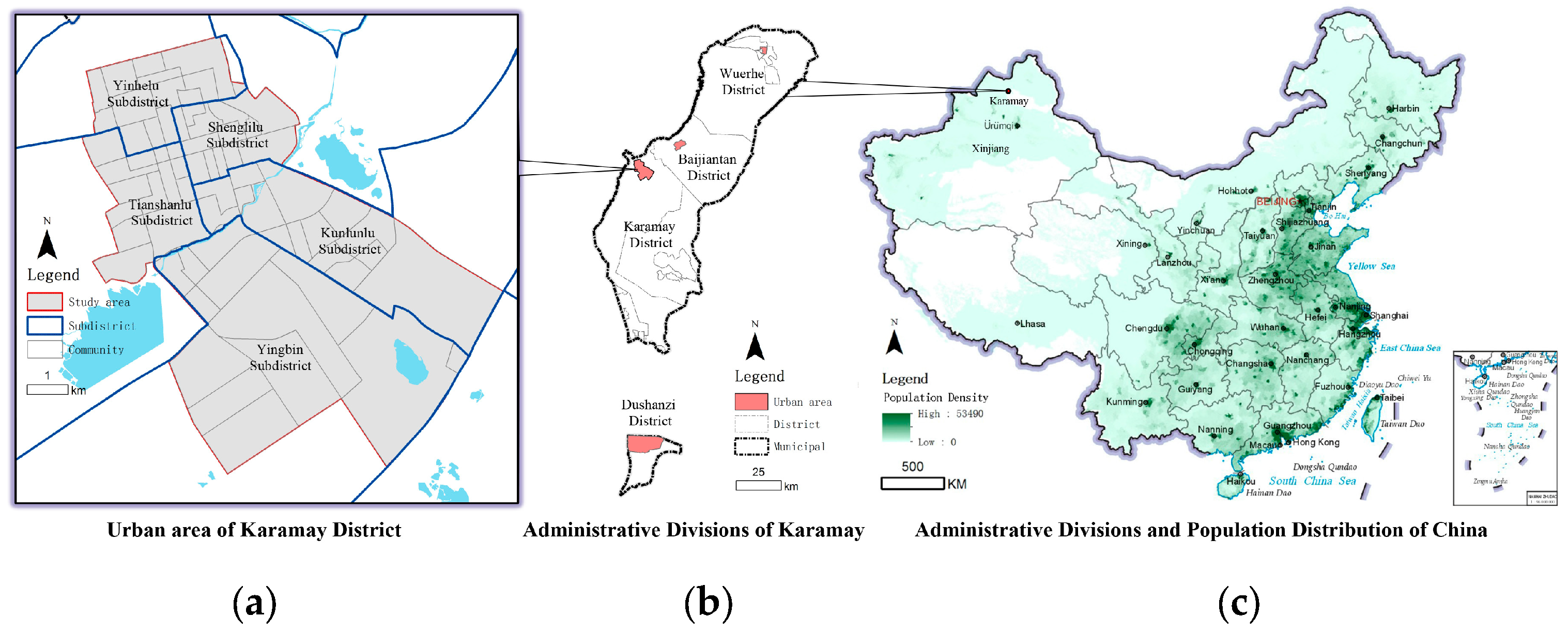
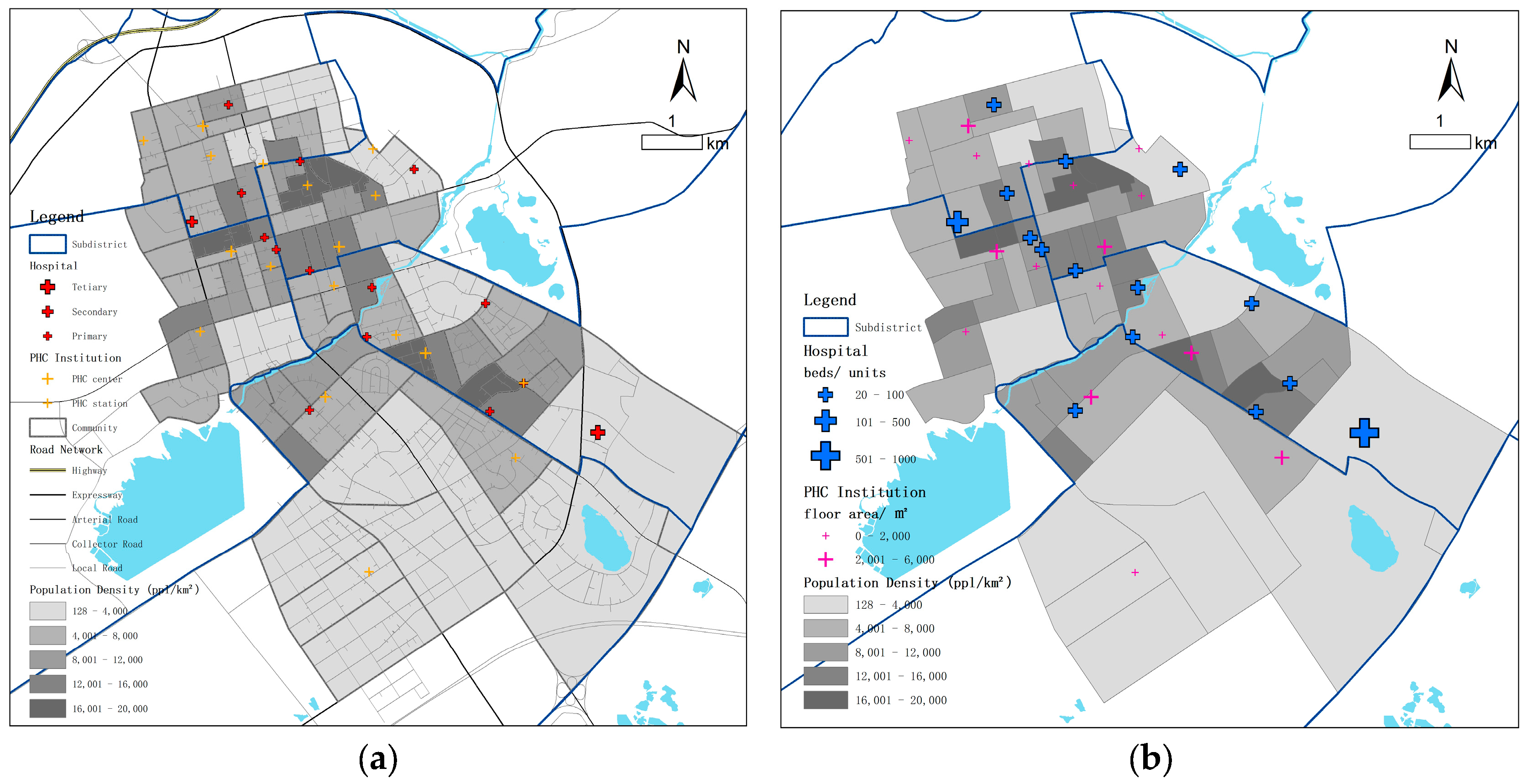

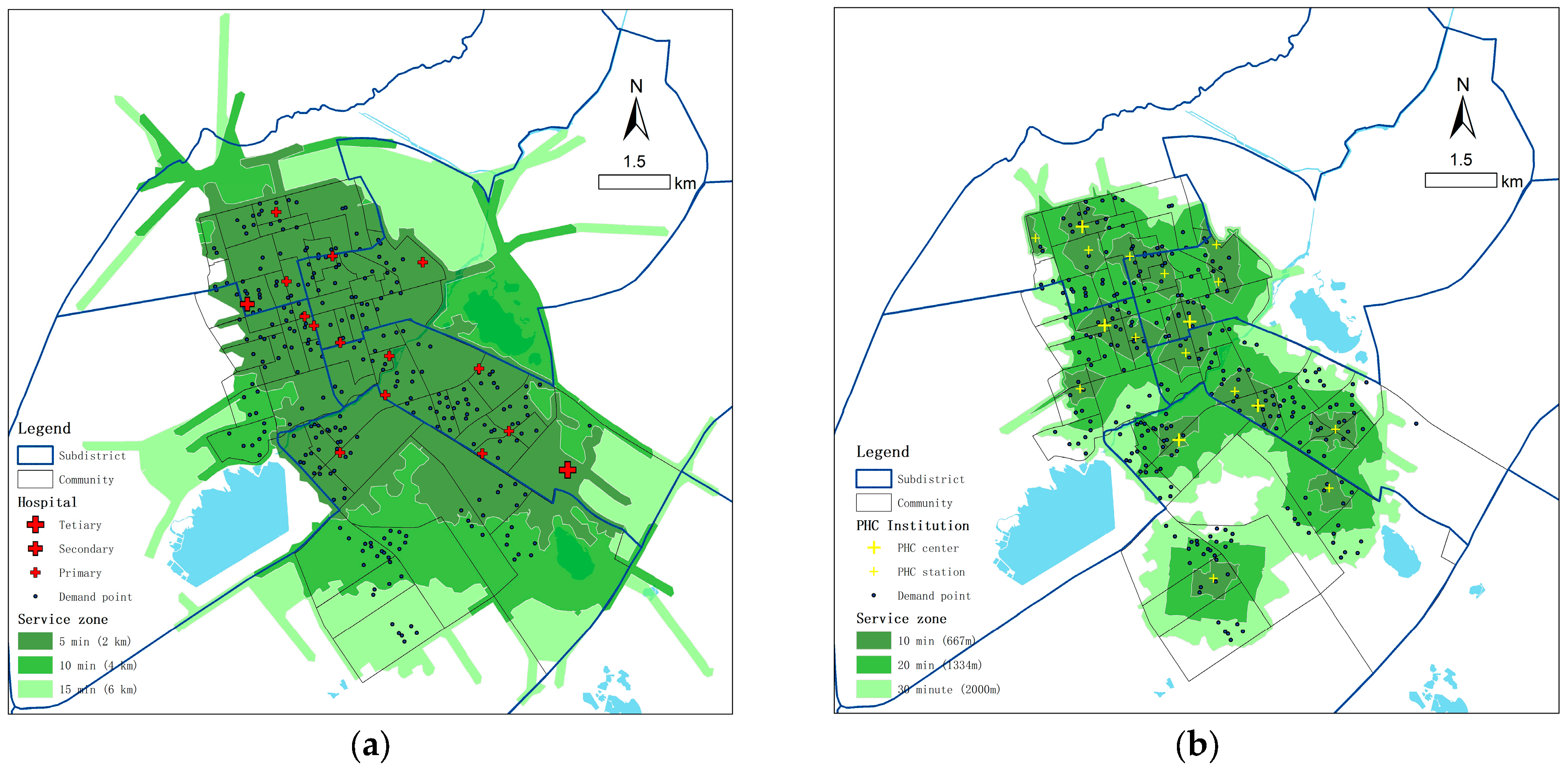
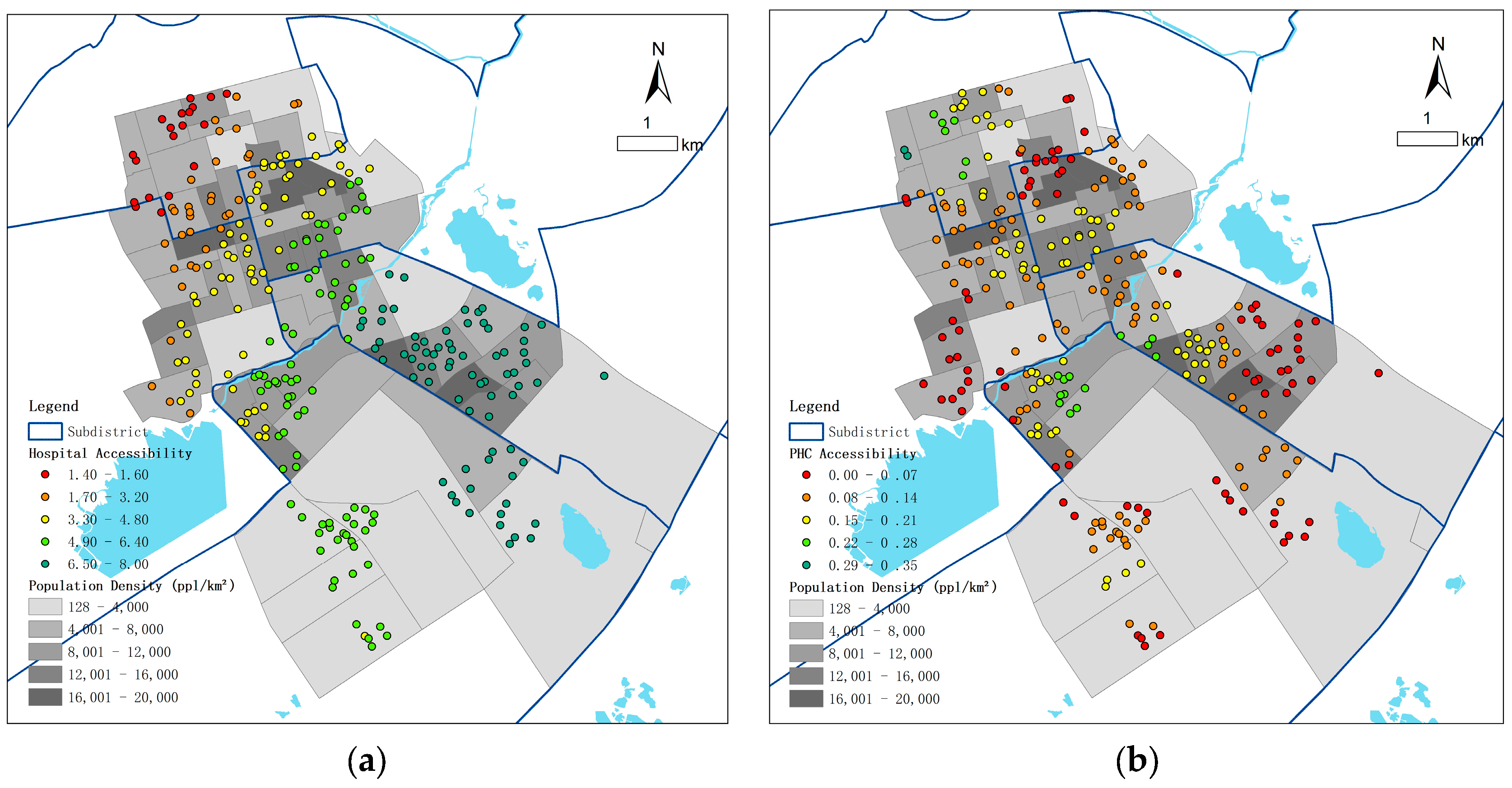
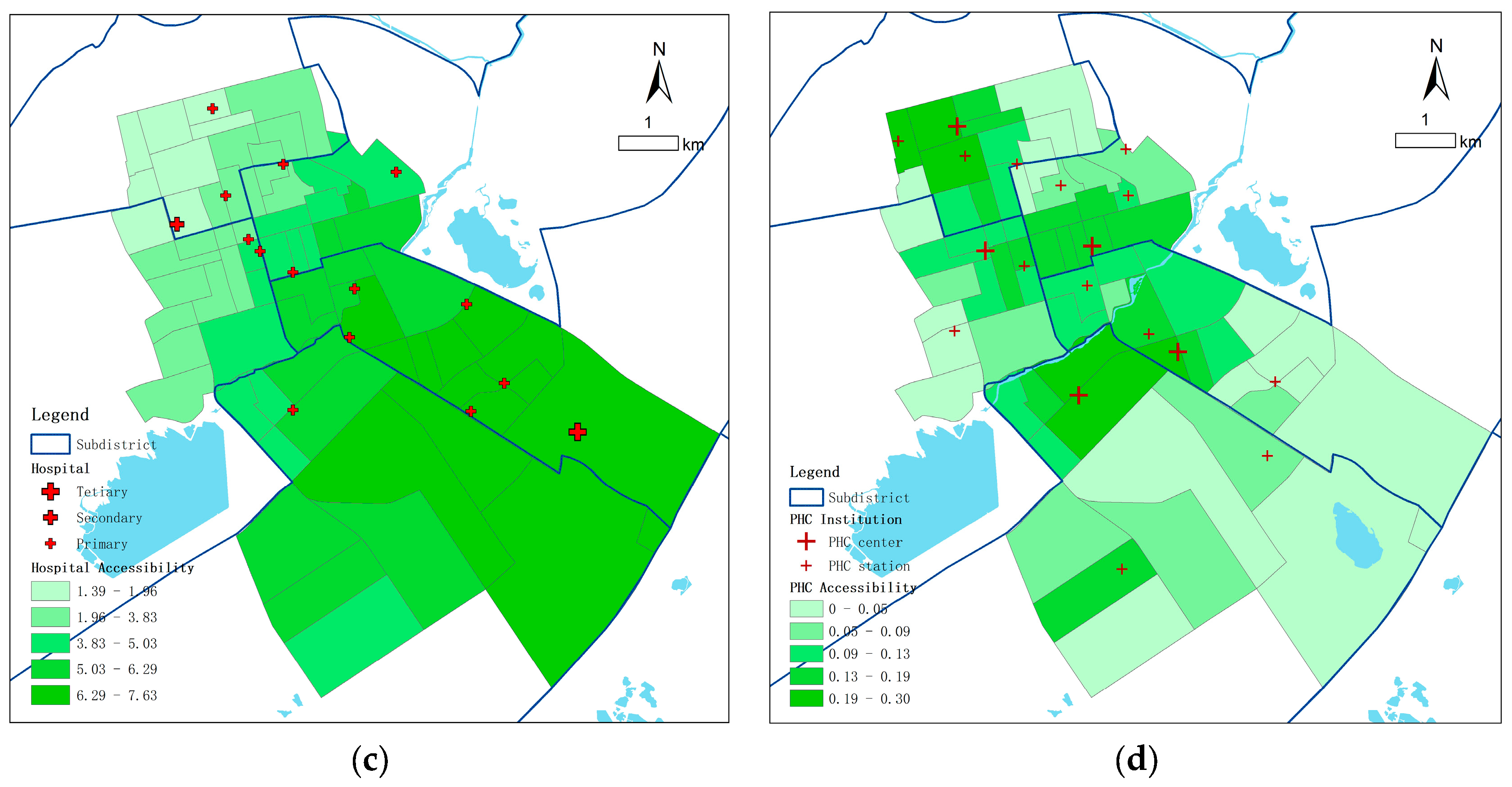
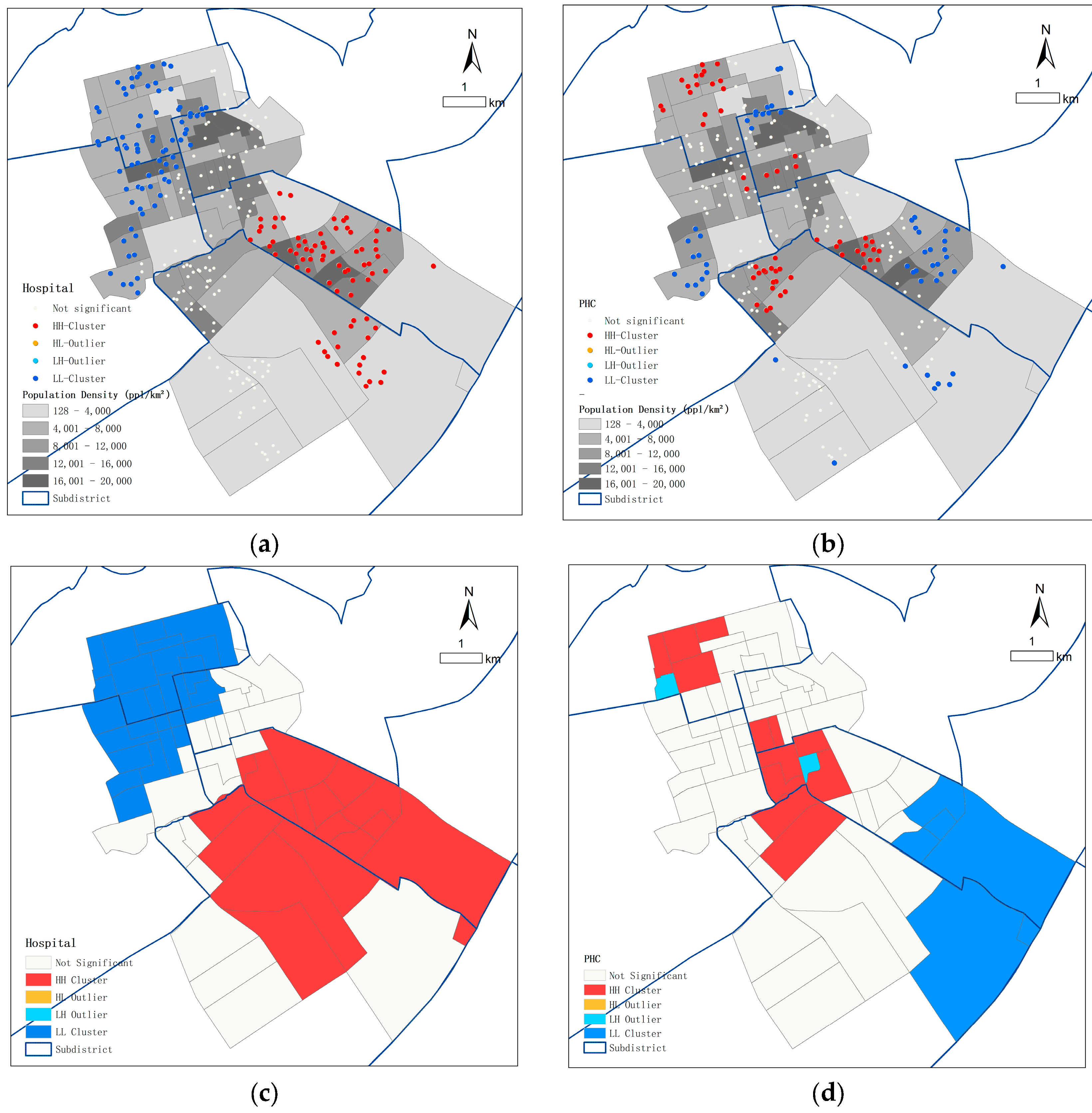

| Index | Count | Statistics of Demand/Supply Scale | ||||
|---|---|---|---|---|---|---|
| Min. | Max. | Mean | SD | |||
| Supply scale | Hospitals (beds) | 15 | 20 | 1000 | 101 | 275 |
| PHC institutions (m2) | 18 | 259 | 5855 | 1713 | 1662 | |
| Demand scale | Compound access (persons) | 274 | 114 | 4714 | 991 | 716 |
| Residential compound (persons) | 160 | 114 | 7428 | 1697 | 1395 | |
| Community (persons) | 67 | 712 | 9815 | 4072 | 2040 | |
| Subdistrict (persons) | 5 | 38,566 | 71,642 | 54,299 | 12,343 | |
| Subdistrict | Mean | Median | Max | Min | SD | CV |
|---|---|---|---|---|---|---|
| Shenglilu | 4.48 0.11 | 4.59|0.11 | 5.52|0.18 | 3.12|0.03 | 0.68|0.05 | 0.15|0.45 |
| Kunlunlu | 6.91|0.10 | 7.16|0.11 | 7.77|0.25 | 5.10|0.00 | 0.69|0.06 | 0.10|0.60 |
| Tianshanlu | 3.46|0.09 | 3.40|0.09 | 5.06|0.17 | 1.48|0.00 | 0.74|0.06 | 0.21|0.67 |
| Yinhelu | 2.18|0.14 | 1.93|0.14 | 4.13|0.31 | 1.36|0.01 | 0.78|0.08 | 0.36|0.57 |
| Yingbin | 5.76|0.07 | 5.49|0.10 | 7.66|0.25 | 4.32|0.00 | 0.95|0.07 | 0.16|1.00 |
| Total | 4.93|0.11 | 5.03|0.11 | 7.77|0.31 | 1.36|0.00 | 1.87|0.07 | 0.38|0.66 |
| Statistic | Value for Hospital Accessibility | Value for PHC Accessibility |
|---|---|---|
| Moran’s I Index | 0.959895 | 0.649227 |
| Expected Index | −0.003663 | −0.003663 |
| Variance | 0.000499 | 0.000498 |
| Z Score | 43.135795 | 29.254173 |
| p Value | 0.000000 | 0.000000 |
| Age | Yinhelu | Tianshanlu | Shenglilu | Kunlunlu | Yingbin | Average |
|---|---|---|---|---|---|---|
| 0–3 | 2.27|0.14 | 3.25|0.06 | 4.52|0.11 | 7.10|0.08 | 5.98|0.11 | 5.28|0.10 |
| (0.20|0.37) | (0.13|0.52) | (0.08|0.23) | (0.05|0.46) | (0.09|0.36) | (0.20|0.42) | |
| 4–6 | 2.25|0.15 | 3.23|0.06 | 4.45|0.11 | 7.12|0.08 | 6.05|0.11 | 5.14|0.10 |
| (0.20|0.35) | (0.12|0.52) | (0.08|0.25) | (0.05|0.47) | (0.10|0.36) | (0.22|0.43) | |
| 7–12 | 2.21|0.15 | 3.22|0.06 | 4.47|0.11 | 7.07|0.08 | 5.74|0.13 | 4.82|0.10 |
| (0.20|0.35) | (0.12|0.52) | (0.08|0.24) | (0.05|0.45) | (0.10|0.34) | (0.23|0.42) | |
| 13–18 | 2.24|0.14 | 3.28|0.08 | 4.55|0.11 | 6.90|0.10 | 5.62|0.13 | 4.68|0.11 |
| (0.20|0.34) | (0.14|0.38) | (0.08|0.23) | (0.06|0.38) | (0.09|0.32) | (0.23|0.35) | |
| 19–45 | 2.24|0.14 | 3.28|0.07 | 4.54|0.11 | 7.03|0.08 | 5.90|0.11 | 5.02|0.10 |
| (0.20|0.36) | (0.13|0.47) | (0.08|0.23) | (0.05|0.44) | (0.10|0.36) | (0.22|0.40) | |
| 46–60 | 2.26|0.14 | 3.32|0.08 | 4.52|0.11 | 6.85|0.10 | 5.76|0.12 | 4.86|0.11 |
| (0.19|0.33) | (0.13|0.40) | (0.08|0.23) | (0.06|0.37) | (0.09|0.34) | (0.21|0.35) | |
| 61–75 | 2.31|0.15 | 3.32|0.09 | 4.56|0.12 | 6.92|0.10 | 5.88|0.12 | 4.94|0.11 |
| (0.18|0.29) | (0.12|0.37) | (0.08|0.22) | (0.06|0.38) | (0.10|0.35) | (0.21|0.35) | |
| 76+ | 2.39|0.14 | 3.44|0.12 | 4.56|0.13 | 6.80|0.13 | 5.84|0.12 | 4.71|0.13 |
| (0.18|0.26) | (0.10|0.22) | (0.08|0.20) | (0.06|0.28) | (0.10|0.35) | (0.21|0.26) | |
| Average | 2.26|0.14 | 3.30|0.08 | 4.53|0.11 | 6.96|0.09 | 5.85|0.12 | 4.93|0.11 |
| (0.20|0.34) | (0.13|0.43) | (0.08|0.23) | (0.06|0.41) | (0.09|0.35) | (0.22|0.38) |
Disclaimer/Publisher’s Note: The statements, opinions and data contained in all publications are solely those of the individual author(s) and contributor(s) and not of MDPI and/or the editor(s). MDPI and/or the editor(s) disclaim responsibility for any injury to people or property resulting from any ideas, methods, instructions or products referred to in the content. |
© 2024 by the authors. Licensee MDPI, Basel, Switzerland. This article is an open access article distributed under the terms and conditions of the Creative Commons Attribution (CC BY) license (https://creativecommons.org/licenses/by/4.0/).
Share and Cite
Liu, L.; Gao, R.; Zhang, L. An Equity Evaluation of Healthcare Accessibility across Age Strata Using the G2SFCA Method: A Case Study in Karamay District, China. Land 2024, 13, 1259. https://doi.org/10.3390/land13081259
Liu L, Gao R, Zhang L. An Equity Evaluation of Healthcare Accessibility across Age Strata Using the G2SFCA Method: A Case Study in Karamay District, China. Land. 2024; 13(8):1259. https://doi.org/10.3390/land13081259
Chicago/Turabian StyleLiu, Lu, Runyi Gao, and Li Zhang. 2024. "An Equity Evaluation of Healthcare Accessibility across Age Strata Using the G2SFCA Method: A Case Study in Karamay District, China" Land 13, no. 8: 1259. https://doi.org/10.3390/land13081259




